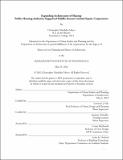| dc.description.abstract | Amid soaring home prices caused by rampant speculation in high-cost cities like Cambridge, middle-income households are being squeezed harder than ever. Faced with a housing market structured around binaries between renting/owning and market-rate/affordable housing (income- and price-restricted), middle-income households are left with increasingly few options. Neither private developers nor public-sector entities currently serve their needs.
Limited-equity cooperatives (LECs) move beyond these binaries. LECs provide a form of self-governed housing, incorporating elements of renting and owning, designed for permanent affordability with limited wealth building via economic sharing. But LECs also facilitate social and spatial sharing through practices (collective decision making, shared meals, and childcare help) enabled by architecture (open space, common kitchen, and play facilities). LECs can thus endow residents with the benefits of collective control, affordability, and social support through the combination of decommodification and architectural design. LECs have existed in the United States for over a century. Apart from a few local exceptions, however, the model has never been scaled for a middle-income clientele, due to a lack of financial and institutional support.
Building on a literature review of US housing history and interviews with residents, policy makers, and developers, “Expanding Architectures of Sharing” argues that LECs can again serve middle-income households if institutions with the financial means and development expertise collaborate. Specifically, this thesis focuses on the healthcare industry and public housing authorities and imagines the following scenario: Members of the Massachusetts Nurses Association union petition the Cambridge Health Alliance, which has been hard pressed to hire staff due to exorbitant housing prices, to offer its surface level parking lot on Line Street for development; The Cambridge Housing Authority is focused on low-income rental housing, but is driven by an entrepreneurial spirit to broaden its impact; A joint venture between the two CHAs provides the financial and institutional support necessary to build a new mixed-use LEC, developed and managed by the Housing Authority.
By embracing the interrelated tenets of economic, social and spatial sharing, the LEC provides a living environment not possible in either market-rate or traditional affordable developments. Organized around four distinct open spaces, the project combines a rental building for hospital interns and a cooperative building for an array of household sizes and incomes. A daycare, retail spaces, and below-grade parking offer public uses. The proposal reveals the untapped opportunity of institutions and housing authorities to expand architectures of sharing through middle-income LECs. | |
